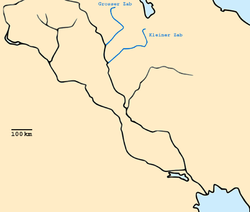Battle of the Zab
This article has multiple issues. Please help improve it or discuss these issues on the talk page. (Learn how and when to remove these template messages)
|
| Battle of the Zab | |||||||
|---|---|---|---|---|---|---|---|
| Part of the Abbasid Revolution | |||||||
 Greater Zab River Map in Iraq | |||||||
| |||||||
| Belligerents | |||||||
|
|
| ||||||
| Commanders and leaders | |||||||
| Marwan II (WIA)[citation needed] | |||||||
| Strength | |||||||
| around 20.000[citation needed] | around 120,000[5] | ||||||
The Battle of the Zab (
Background
In 747, a major rebellion broke out against the
The armies
In 750, the army of the Umayyad
The battle
The Abbasid army formed a spear wall, a tactic they had adopted from their Umayyad opponents, presumably from witnessing it in earlier battles. This entailed standing in a battle line with their lances pointed at the enemy (similar to the stakes used by English longbowmen at Agincourt and Crécy many centuries later). The Umayyad cavalry charged, possibly believing that with their experience they could break the spear wall. This was a mistake on their part, however, and they were all but butchered. The Umayyad army fell into retreat, its morale finally shattered. Many were cut down by the zealous Abbasids or were drowned in the wintertime River Zab.
Aftermath
See also
- Battle of Talas was a military engagement between the Abbasid Caliphate against the Chinese Tang dynasty in July 751 AD.
References
Citations
- Encyclopedia Britannica. Retrieved 17 December 2019.
Abū Muslim déclencha l'opération en 747 et la victoire fut acquise à la bataille du Grand Zāb en 750. Ibrāhīm étant mort entre-temps, Abū Muslim proclama calife son frère Abū l-'Abbās, dit as-Saffāḥ, en 749 à Kūfa. Abū Muslim started the operation in 747 and victory was gained at the Battle of the Great Zāb in 750. Ibrāhīm having died in the meantime, Abū Muslim proclaimed [as] caliph his brother Abū l-'Abbās, known as as-Saffāḥ, in 749 in Kūfa.
- ^ Kennedy, H. (2004). The prophet and the age of the caliphates. 2nd ed.
- ^ Zetterstéen 1987, pp. 22–23.
- ^ Grohmann & Kennedy 1995, p. 985.
- ^ Ibn Kathir Al-Bidāya wa-n-Nihāya (The Beginning and The End)
Sources
- Grohmann, Adolph & Kennedy, Hugh (1995). "Ṣāliḥ b. ʿAlī". In ISBN 978-90-04-09834-3.
- ISBN 90-04-08265-4.
Further reading
- Afsaruddin, Asma (8 March 2018). "Islamic History: Umayyad Dynasty". Encyclopædia Britannica. J.E. Luebering, Exec. Dir., Core Editorial Group (online ed.). Chicago, IL: Encyclopædia Britannica. Retrieved 17 December 2019. See also the topic, Battle of the Great Zab River.
- "Islamic History: Abbasid Caliphate". Encyclopædia Britannica (online ed.). Chicago, IL: Encyclopædia Britannica. 2019. Retrieved 17 December 2019. See also the topic, Battle of the Great Zab River.
- Kennedy, Hugh N. (n.d.). The Court of the Caliphs – When Baghdad Ruled the Muslim World. Unknown location: Unknown publisher.[ISBN missing]
